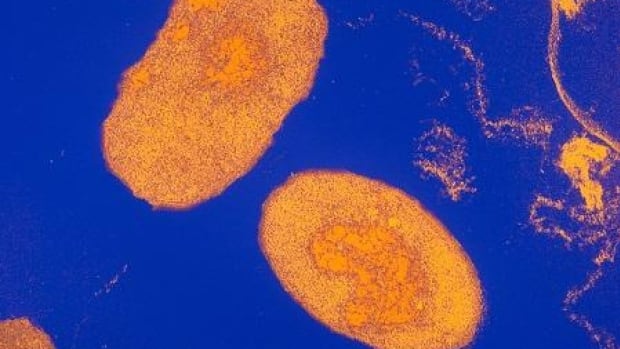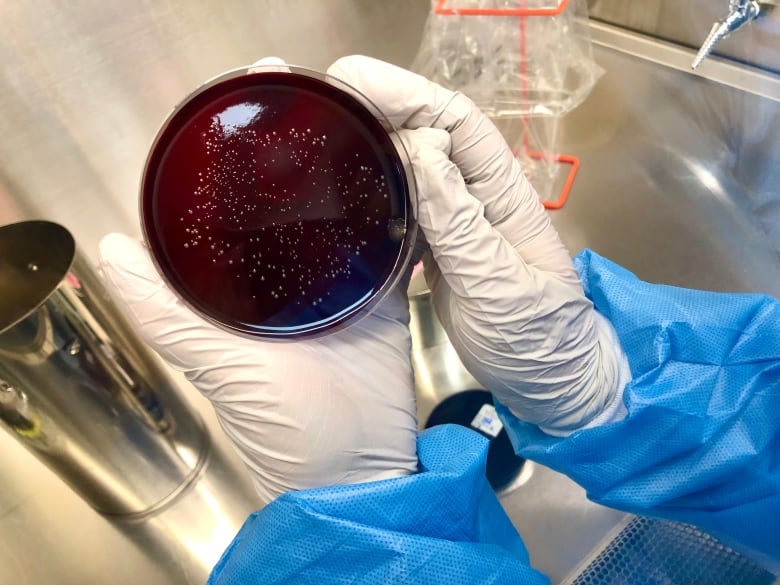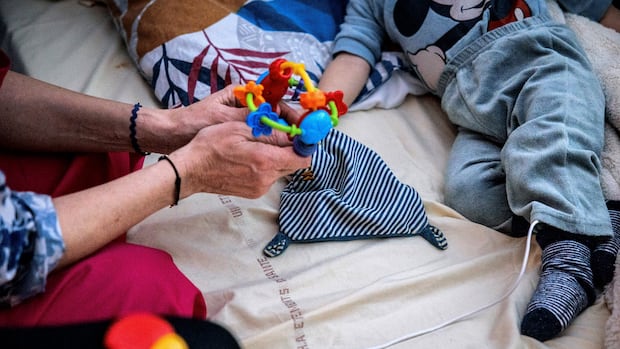
This story is part of CBC Health’s Second Opinion, a weekly analysis of health and medical science news emailed to subscribers on Saturday mornings. If you haven’t subscribed yet, you can do that by clicking here.
The classic sound of whooping cough is grating and unmistakable: A harsh, deep hacking that’s often followed by a distinctive “whoop” as patients struggle to breathe.
It’s not the kind of infection anyone wants to get, and for vulnerable individuals, it can turn deadly. But the number of people catching it recently in Canada — kids and teens, primarily — is soaring to staggering levels.
More than 12,000 cases of whooping cough, also known as pertussis or the 100-day cough, have been reported to date in 2024, the Public Health Agency of Canada (PHAC) told CBC News, citing media reports from across the country. That’s far higher than the roughly 500 to 4,500 nationwide infections typically reported each year.
Caused by a bacteria called Bordetella pertussis, the vast majority of this year’s whooping cough cases are in Quebec, though various other provinces also started experiencing outbreaks or higher-than-usual case counts in recent months. So far, the disease is mainly striking youth aged 10 to 14, Quebec health officials recently told The Canadian Press.
“Although increased pertussis activity is expected after record-low activity during the pandemic years … the numbers of cases seen in Quebec, New Brunswick, Prince Edward Island and Newfoundland and Labrador in 2024 exceed pre-pandemic peak years,” a PHAC spokesperson said in a statement.
The massive spike in infections echoes a similar trend seen in the U.S. and across Europe over the last year. And scientists familiar with whooping cough say the surge is caused by a confluence of factors, creating a perfect storm that’s putting society’s youngest at risk of serious illness.
“I think what happened is not a surprise given the cyclical nature of how we see pertussis, but what’s a surprise is the magnitude and the scale,” said clinician-scientist Dr. May ElSherif, the associate director for laboratory management at the Canadian Centre for Vaccinology in Halifax.
Whooping cough cases are spiking across multiple provinces, with the most dramatic surge in Quebec. Doctors warn that infants and young children are most at risk, with many urging vaccination.
‘Adults often break their ribs’
Pertussis is highly contagious, and while symptoms can be mild for many individuals, infections can also lead to pneumonia, brain damage or life-threatening illness.
“Whooping cough isn’t just something that’s kind of in Victorian novels. It’s something that people still get and it can be very disabling,” said infectious diseases specialist Dr. Amesh Adalja, a senior scholar at the Johns Hopkins Center for Health Security in Baltimore.
“Adults often break their ribs because they cough so violently.”
But newborns, particularly those who don’t yet have any protection from pertussis vaccines, are also among those getting the sickest or even dying, stressed Dr. Jesse Papenburg, a clinician and researcher with the Montreal Children’s Hospital.
“It’s really children — young children, infants, and especially those around six months of life — that are at highest risk of complications,” he said.
During Europe’s recent pertussis outbreak, which involved more than 60,000 total cases throughout 2023 and the first quarter of 2024, at least eight older adults died along with 11 infants, according to the European Centre for Disease Prevention and Control.
So what’s behind these surges?
One factor is simply the usual ebbs and flows of pertussis, which tends to circulate more in some years than others. It’s not uncommon to have localized whooping cough epidemics, noted Dr. Anna Banerji, a pediatric infectious diseases specialist and associate professor at the University of Toronto.
“A lot of these bacteria and viruses are cyclic,” she said, “and so they come in waves.”

3 to 5-year cycles
While some pathogens evolve rapidly and strike every year, pertussis tends to rise and fall over three to five-year cycles, which is likely linked to shifting patterns in population-level immunity as new, susceptible groups provide the bacteria with fresh “kindling” to spark outbreaks, Adalja explained.
“There’s always new people being born into the population that don’t have immunity,” he said.
That can mean infants born to unvaccinated mothers — those who didn’t get a pertussis booster shot during their pregnancy, which can transfer protection to the fetus — or young children who didn’t receive their full set of routine immunizations.
Immunity provided by vaccines or prior pertussis infections also doesn’t last for life, noted the Canadian Centre for Vaccinology’s ElSharif. “The current vaccines we have aren’t the best,” she said. “They don’t offer lifelong protection, but we do encourage people to take them, because they do, for the short-term, offer protection against disease.”
While those societal trends may explain whooping cough’s usual ups and downs, multiple scientists and clinicians agreed that what’s playing out right now, with case counts suddenly soaring, is likely yet another aftershock of the COVID-19 pandemic.
Ripple effects from COVID-19 pandemic
During the early years of the pandemic, amid countries’ various reactions on travel and gatherings, respiratory illnesses like pertussis and influenza largely vanished.
One retrospective study published in 2022, focusing on 20 health care facilities in the U.S., found there was “no whooping cough during the first year of the COVID-19 pandemic” whatsoever.
“Basically what the pandemic did was that the rate of immunity through natural exposure went down,” said ElSharif.
Various infections came roaring back once pandemic restrictions were lifted. Influenza, respiratory syncytial virus (RSV) and a form of bacterial pneumonia all made headlines for resurfacing in larger waves, or at unusual times, in recent years — at times overwhelming hospitals in Canada and beyond. Whooping cough, it seems, is just the latest to rear its head.
At the same time, there were major disruptions to routine immunization programs, leading to years of catch-up.
An exclusive look at a lab where Canadians are getting sick on purpose to help scientists study whooping cough — and one day develop a new vaccine.
Globally, the vaccination rate for three doses of the diphtheria-tetanus-pertussis vaccine fell from around 86 per cent in 2019 to 83 per cent in 2020, meaning 22.7 million children around the world missed out, estimates from the World Health Organization and UNICEF suggest.
In New Brunswick, officials recently warned of a growing whooping cough outbreak, with more than 140 cases so far this year, far exceeding the five-year annual average of 34. There, recent vaccination rates among children are around 80 per cent — fairly high, but still low enough to fuel more spread.
“The further away from 90 per cent up-to-date immunity we get with very infectious respiratory things, whether it’s a virus or a bacteria, then we start to see the opportunity for outbreaks,” Dr. Lisa Barrett, an assistant professor at Dalhousie University’s School of Medicine, told CBC New Brunswick.
Push for new vaccines
Scientists are hopeful this global surge of pertussis will die down, with the bacterial infection eventually settling back into more predictable patterns.
Yet given its toll on vulnerable groups, and the lack of durable protection from current pertussis vaccines, there’s a growing push to quash whooping cough beyond these recent outbreaks.
Part of the challenge is the makeup of commonly-used pertussis shots, noted Adalja. Earlier versions were whole-cell vaccines, referring to a form that’s prepared in labs using entire cells, which can lead to a potent immune response. In the case of pertussis shots, the approach led to major drops in infections — but the vaccines were also linked to more serious side effects.
The type of shot now used around the world is an acellular vaccine, which doesn’t use any whole virus or bacteria cells but instead relies on purified fragments of a particular pathogen.
Both forms are effective, data shows, but the protection provided by acellular shots tends to drop more quickly, leaving people vulnerable to infections sooner.
That’s a key part of the reason why whooping cough is still around despite decades’ worth of immunization campaigns, Adalja said.
At the Canadian Centre for Vaccinology, ElSharif’s Halifax-based team has spent several years conducting human challenge trials for pertussis — in which adult patients are willingly getting infected under strict monitoring — in hopes the study will help inform how to develop more effective vaccines.

While results aren’t published just yet, ElSharif said her team has gained new insight into how pertussis operates inside the body, including confirmation that for some adults, active infections don’t lead to any symptoms, meaning some individuals may be able to silently spread it to other vulnerable groups.
Given the global toll of whooping cough even before this year’s massive outbreaks, with an estimated 160,000 annual deaths among children under five, ElSharif said it’s crucial to focus on beating back this vaccine-preventable disease.
“The pathway to a vaccine is not a short one,” she said.

